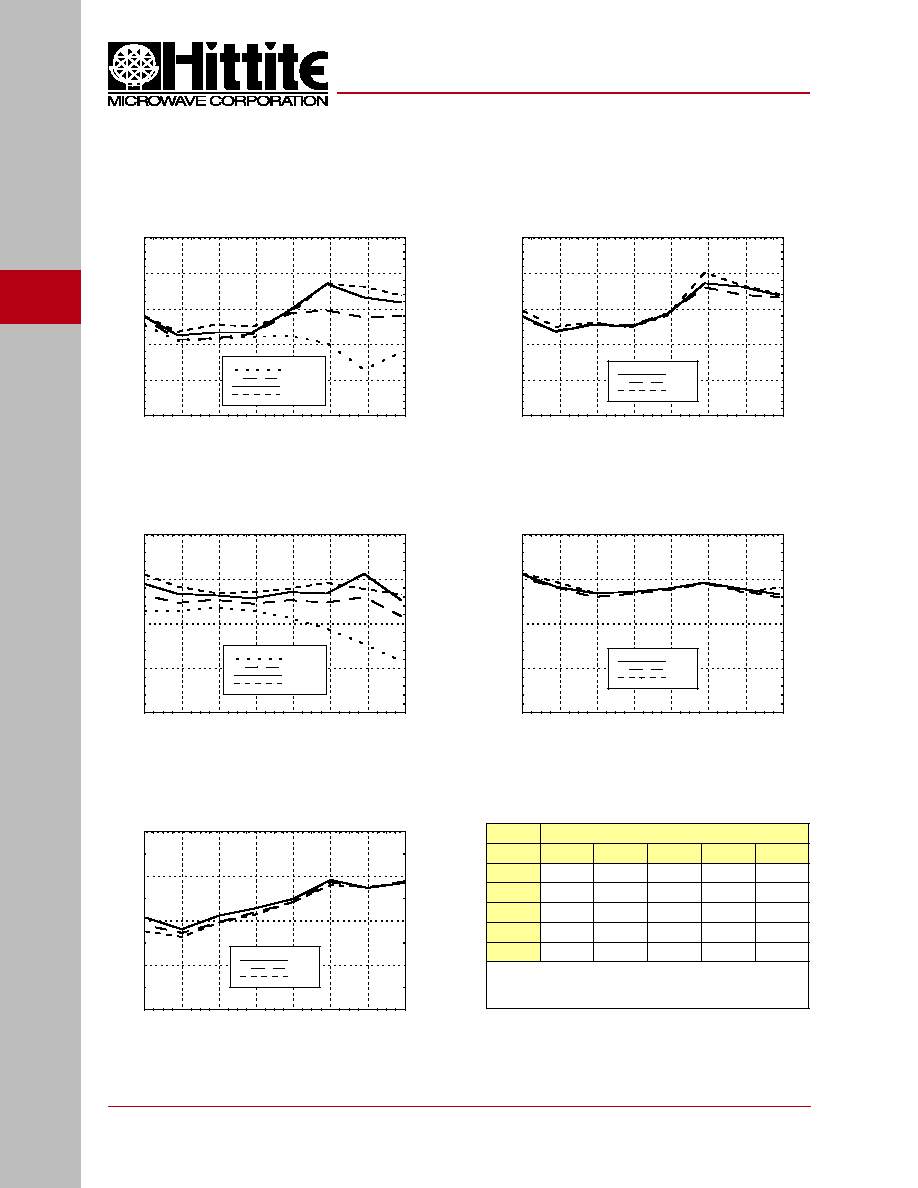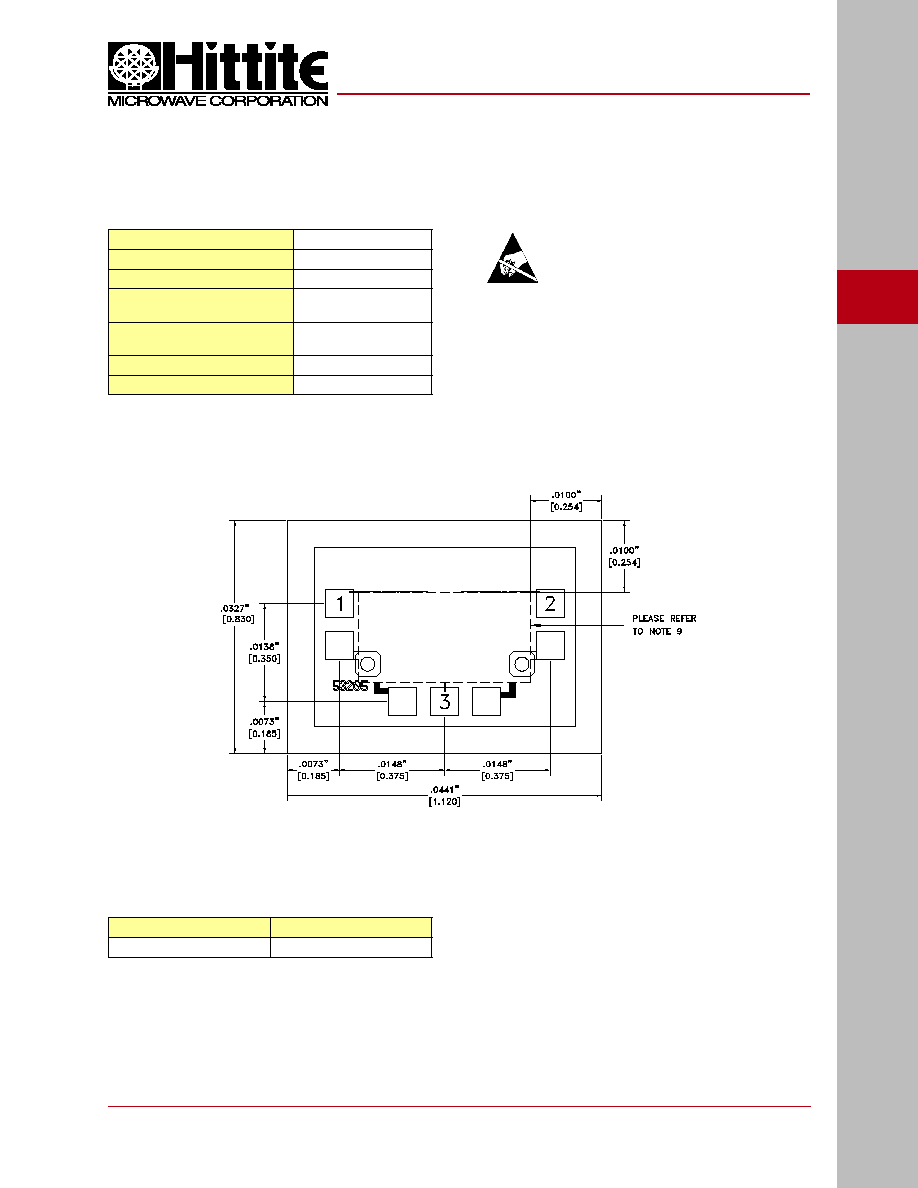 | –≠–ª–µ–∫—Ç—Ä–æ–Ω–Ω—ã–π –∫–æ–º–ø–æ–Ω–µ–Ω—Ç: HMC553 | –°–∫–∞—á–∞—Ç—å:  PDF PDF  ZIP ZIP |

M
I
X
E
R
S
- C
H
I
P
3
3 - 174
For price, delivery, and to place orders, please contact Hittite Microwave Corporation:
20 Alpha Road, Chelmsford, MA 01824 Phone: 978-250-3343 Fax: 978-250-3373
Order On-line at www.hittite.com
HMC553
GaAs MMIC FUNDAMENTAL
MIXER, 7 - 14 GHz
v00.1205
General Description
Features
Functional Diagram
High LO/RF Isolation: 48 dB
Passive Double Balanced Topology
Low Conversion Loss: 7 dB
Wide IF Bandwidth: DC - 5 GHz
Small Size: 0.83 x 1.12 x 0.1 mm
Typical Applications
The HMC553 is ideal for:
∑ Microwave Radio
∑ Military & Space
∑ Communications, Radar & EW
The HMC553 is a passive double balanced mixer
that can be used as an upconverter or downconverter
between 7 and 14 GHz. The miniature monolithic
mixer is fabricated in a GaAs MESFET process, and
requires no external components or matching circu-
itry. The HMC553 operates with LO drive levels as
low as +9 dBm and provides excellent LO to RF and
LO to IF isolation due to optimized balun structures.
Measurements were made with the chip mounted
into in a 50 ohm test fi xture and includes the para-
sitic effects of wire bond assembly. Connections were
made with a 1 mil wire bond with minimal length (<12
mil).
Electrical Specifications,
T
A
= +25∞ C, IF= 100 MHz, LO= +13 dBm*
Parameter
Min.
Typ.
Max.
Min.
Typ.
Max.
Units
Frequency Range, RF & LO
7 - 11
11 - 14
GHz
Frequency Range, IF
DC - 5
DC - 5
GHz
Conversion Loss
7
9.5
8
10
dB
Noise Figure (SSB)
7
9.5
8
10
dB
LO to RF Isolation
40
48
35
45
dB
LO to IF Isolation
28
33
30
35
dB
RF to IF Isolation
15
22
25
28
dB
IP3 (Input)
18
22
dBm
IP2 (Input)
48
48
dBm
1 dB Gain Compression (Input)
10
11.5
dBm
*Unless otherwise noted, all measurements performed as downconverter, IF= 100 MHz.

M
I
X
E
R
S
- C
H
I
P
3
3 - 175
For price, delivery, and to place orders, please contact Hittite Microwave Corporation:
20 Alpha Road, Chelmsford, MA 01824 Phone: 978-250-3343 Fax: 978-250-3373
Order On-line at www.hittite.com
Conversion Gain vs.
Temperature @ LO = +13 dBm
Conversion Gain vs. LO Drive
Isolation @ LO = +13 dBm
IF Bandwidth @ LO = +13 dBm
Return Loss @ LO = +13 dBm
Upconverter Performance
Conversion Gain vs. LO Drive
-20
-15
-10
-5
0
6
7
8
9
10
11
12
13
14
15
+25C
+85C
-55C
CONVERSION GAIN (dB)
FREQUENCY (GHz)
HMC553
GaAs MMIC FUNDAMENTAL
MIXER, 7 - 14 GHz
v00.1205
-25
-20
-15
-10
-5
0
6
7
8
9
10
11
12
13
14
15
RF
LO
RETURN LOSS (dB)
FREQUENCY (GHz)
-20
-15
-10
-5
0
6
7
8
9
10
11
12
13
14
15
+9 dBm
+11 dBm
+13 dBm
+15 dBm
CONVERSION GAIN (dB)
FREQUENCY (GHz)
-20
-15
-10
-5
0
0
1
2
3
4
5
6
IF Return Loss
Conversion Gain
RESPONSE (dB)
FREQUENCY (GHz)
-20
-15
-10
-5
0
6
7
8
9
10
11
12
13
14
15
+9 dBm
+11 dBm
+13 dBm
+15 dBm
CONVERSION GAIN (dB)
FREQUENCY (GHz)
-60
-50
-40
-30
-20
-10
0
6
7
8
9
10
11
12
13
14
15
RF/IF
LO/RF
LO/IF
ISOLATION (dB)
FREQUENCY (GHz)

M
I
X
E
R
S
- C
H
I
P
3
3 - 176
For price, delivery, and to place orders, please contact Hittite Microwave Corporation:
20 Alpha Road, Chelmsford, MA 01824 Phone: 978-250-3343 Fax: 978-250-3373
Order On-line at www.hittite.com
Input IP2 vs.
Temperature @ LO = +13 dBm *
Input IP3 vs. LO Drive *
Input IP3 vs.
Temperature @ LO = +13 dBm *
Input IP2 vs. LO Drive *
* Two-tone input power = -5 dBm each tone, 1 MHz spacing.
Input P1dB vs.
Temperature @ LO = +13 dBm
HMC553
GaAs MMIC FUNDAMENTAL
MIXER, 7 - 14 GHz
v00.1205
5
10
15
20
25
30
7
8
9
10
11
12
13
14
+9 dBm
+11 dBm
+13 dBm
+15 dBm
INPUT IP3 (dBm)
FREQUENCY (GHz)
20
30
40
50
60
7
8
9
10
11
12
13
14
+25C
+85C
-40C
INPUT IP2 (dBm)
FREQUENCY (GHz)
20
30
40
50
60
7
8
9
10
11
12
13
14
+9 dBm
+11 dBm
+13 dBm
+15 dBm
INPUT IP2 (dBm)
FREQUENCY (GHz)
5
10
15
20
25
30
7
8
9
10
11
12
13
14
+25C
+85C
-40C
INPUT IP3 (dBm)
FREQUENCY (GHz)
MxN Spurious Outputs
nLO
mRF
0
1
2
3
4
0
xx
7
50
38
58
1
22
0
41
53
65
2
100
72
62
73
102
3
103
100
96
71
90
4
xx
105
101
104
111
RF = 10.1 GHz @ -10 dBm
LO = 10 GHz @ +13 dBm
All values in dBc below the IF output power level.
6
8
10
12
14
7
8
9
10
11
12
13
14
+25C
+85C
-40C
INPUT P1dB (dBm)
FREQUENCY (GHz)

M
I
X
E
R
S
- C
H
I
P
3
3 - 177
For price, delivery, and to place orders, please contact Hittite Microwave Corporation:
20 Alpha Road, Chelmsford, MA 01824 Phone: 978-250-3343 Fax: 978-250-3373
Order On-line at www.hittite.com
Outline Drawing
Absolute Maximum Ratings
NOTES:
1. ALL DIMENSIONS ARE IN INCHES [MM].
2. DIE THICKNESS IS .004".
3. TYPICAL BOND PAD IS .004" SQUARE.
4. BOND PAD SPACING CENTER TO CENTER IS .006".
5. BACKSIDE METALLIZATION: GOLD.
6. BOND PAD METALLIZATION: GOLD.
7. BACKSIDE METAL IS GROUND.
8. CONNECTION NOT REQUIRED FOR UNLABELED BOND PADS.
9. THIS DIE IS DESIGNED FOR PICK-UP WITH VACUUM (EDGE)
COLLET TOOLS. TO PRECLUDE THE RISK OF PERMANENT
DAMAGE, NO CONTACT TO THE DIE SURFACE IS ALLOWED
WITHIN THIS RECTANGULAR AREA.
Die Packaging Information
[1]
Standard
Alternate
WP-7
[2]
[1] Refer to the "Packaging Information" section for die
packaging dimensions.
[2] For alternate packaging information contact Hittite
Microwave Corporation.
ELECTROSTATIC SENSITIVE DEVICE
OBSERVE HANDLING PRECAUTIONS
HMC553
GaAs MMIC FUNDAMENTAL
MIXER, 7 - 14 GHz
v00.1205
RF / IF Input
+25 dBm
LO Drive
+25 dBm
Channel Temperature
150 ∞C
Continuous Pdiss (T = 85 ∞C)
(derate 4.09 mW/∞C above 85 ∞C)
266 mW
Thermal Resistance
(channel to die bottom)
244 ∞C/W
Storage Temperature
-65 to +150 ∞C
Operating Temperature
-55 to +85 ∞C

M
I
X
E
R
S
- C
H
I
P
3
3 - 178
For price, delivery, and to place orders, please contact Hittite Microwave Corporation:
20 Alpha Road, Chelmsford, MA 01824 Phone: 978-250-3343 Fax: 978-250-3373
Order On-line at www.hittite.com
HMC553
GaAs MMIC FUNDAMENTAL
MIXER, 7 - 14 GHz
v00.1205
Pad Number
Function
Description
Interface Schematic
1
LO
This pad is DC coupled and matched
to 50 Ohm from 7 to 14 GHz.
2
RF
This pad is DC coupled and matched
to 50 Ohm from 7 to 14 GHz.
3
IF
This pad is DC coupled. For applications not requiring oper-
ation to DC, this port should be DC blocked externally using
a series capacitor whose value has been chosen to pass the
necessary IF frequency range. For operation to DC, this pin
must not source or sink more than 2 mA of current or part
non-function and possible part failure will result.
Pad Descriptions
Assembly Drawing

M
I
X
E
R
S
- C
H
I
P
3
3 - 179
For price, delivery, and to place orders, please contact Hittite Microwave Corporation:
20 Alpha Road, Chelmsford, MA 01824 Phone: 978-250-3343 Fax: 978-250-3373
Order On-line at www.hittite.com
Mounting & Bonding Techniques for Millimeterwave GaAs MMICs
The die should be attached directly to the ground plane eutectically or with
conductive epoxy (see HMC general Handling, Mounting, Bonding Note).
50 Ohm Microstrip transmission lines on 0.127mm (5 mil) thick alumina thin fi lm
substrates are recommended for bringing RF to and from the chip (Figure 1). If
0.254mm (10 mil) thick alumina thin fi lm substrates must be used, the die should
be raised 0.150mm (6 mils) so that the surface of the die is coplanar with the surface
of the substrate. One way to accomplish this is to attach the 0.102mm (4 mil) thick
die to a 0.150mm (6 mil) thick molybdenum heat spreader (moly-tab) which is then
attached to the ground plane (Figure 2).
Microstrip substrates should be brought as close to the die as possible in order to
minimize ribbon bond length. Typical die-to-substrate spacing is 0.076mm (3 mils).
Gold ribbon of 0.075 mm (3 mil) width and minimal length <0.31 mm (<12 mils) is
recommended to minimize inductance on RF, LO & IF ports.
Handling Precautions
Follow these precautions to avoid permanent damage.
Storage: All bare die are placed in either Waffl e or Gel based ESD protective
containers, and then sealed in an ESD protective bag for shipment. Once the
sealed ESD protective bag has been opened, all die should be stored in a dry
nitrogen environment.
Cleanliness: Handle the chips in a clean environment. DO NOT attempt to clean
the chip using liquid cleaning systems.
Static Sensitivity: Follow ESD precautions to protect against > ± 250V ESD
strikes.
Transients: Suppress instrument and bias supply transients while bias is applied.
Use shielded signal and bias cables to minimize inductive pick-up.
General Handling: Handle the chip along the edges with a vacuum collet or with
a sharp pair of bent tweezers. The surface of the chip has fragile air bridges and
should not be touched with vacuum collet, tweezers, or fi ngers.
Mounting
The chip is back-metallized and can be die mounted with AuSn eutectic preforms
or with electrically conductive epoxy. The mounting surface should be clean and fl at.
Eutectic Die Attach: A 80/20 gold tin preform is recommended with a work surface temperature of 255 ∞C and a tool temperature
of 265 ∞C. When hot 90/10 nitrogen/hydrogen gas is applied, tool tip temperature should be 290 ∞C. DO NOT expose the chip
to a temperature greater than 320 ∞C for more than 20 seconds. No more than 3 seconds of scrubbing should be required for
attachment.
Epoxy Die Attach: Apply a minimum amount of epoxy to the mounting surface so that a thin epoxy fi llet is observed around the
perimeter of the chip once it is placed into position. Cure epoxy per the manufacturer's schedule.
Wire Bonding
Ball or wedge bond with 0.025 mm (1 mil) diameter pure gold wire is recommended. Thermosonic wirebonding with a nominal stage
temperature of 150 ∞C and a ball bonding force of 40 to 50 grams or wedge bonding force of 18 to 22 grams is recommended. Use
the minimum level of ultrasonic energy to achieve reliable wirebonds. Wirebonds should be started on the chip and terminated on
the package or substrate. All bonds should be as short as possible <0.31 mm (12 mils).
0.102mm (0.004") Thick GaAs MMIC
Wire Bond
RF Ground Plane
0.127mm (0.005") Thick Alumina
Thin Film Substrate
0.076mm
(0.003")
Figure 1.
0.102mm (0.004") Thick GaAs MMIC
Wire Bond
RF Ground Plane
0.254mm (0.010") Thick Alumina
Thin Film Substrate
0.076mm
(0.003")
Figure 2.
0.150mm (0.005") Thick
Moly Tab
HMC553
GaAs MMIC FUNDAMENTAL
MIXER, 7 - 14 GHz
v00.1205





